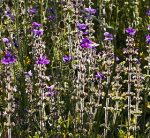 Also called annual clary and orval, this annual plant is native to the area from the Mediterranean to the Crimea and into Iran. It is a member of the deadnettle family, Laminaceae, that also includes mint, basil and beebalm. Growing up 1-2′ high, the plant forms multibranched clumps with square erect stems bearing 2″ long simple leaves. From summer to fall terminal racemes of tiny cream-colored two-lipped flowers appear in whorls and are subtended by broad 1/2″ long bract with pointed tips. The bracts may be white, violet, pink, red, purple, or striped depending on the cultivar. Plants add a vertical accent to borders especially when massed or planted in groups and may be grown in pots. They attract butterflies and hummingbirds and are ignored by rabbits and deer. The genus name, Salvia, , comes from the Latin word salveo meaing save or heal and refers to the medicinal attributes of some species. The specific epithet, viridis, is the Latin word for green, and implies vigor, a characteristic of the growth of the plant.
Also called annual clary and orval, this annual plant is native to the area from the Mediterranean to the Crimea and into Iran. It is a member of the deadnettle family, Laminaceae, that also includes mint, basil and beebalm. Growing up 1-2′ high, the plant forms multibranched clumps with square erect stems bearing 2″ long simple leaves. From summer to fall terminal racemes of tiny cream-colored two-lipped flowers appear in whorls and are subtended by broad 1/2″ long bract with pointed tips. The bracts may be white, violet, pink, red, purple, or striped depending on the cultivar. Plants add a vertical accent to borders especially when massed or planted in groups and may be grown in pots. They attract butterflies and hummingbirds and are ignored by rabbits and deer. The genus name, Salvia, , comes from the Latin word salveo meaing save or heal and refers to the medicinal attributes of some species. The specific epithet, viridis, is the Latin word for green, and implies vigor, a characteristic of the growth of the plant.
Type: Annual
Bloom: Terminal racemes of tiny cream-colored two-lipped flowers appear in whorls and are subtended by broad 1/2″ long bract with pointed tips from summer to fall
Size: 1-2′ H x 2′ W
Light: Full sun to partial shade
Soil: Fertile, medium moist, well-drained
Hardiness: Tender; does better in cool climates
Care: Deadhead to extend bloom time
Pests and Diseases: None of significance
Propagation: Seed
Companion Plants: Marigold, zinnia, melampodium, annual ageratum
Outstanding Selections:
‘Alba’ (white bracts)
‘Bluebeard’ (pale violet bracts with darker veins)
‘Claryssa’ (dwarf, purple, pink or white bracts)
‘Oxford Blue’ ((blue-purple bracts)
‘Pink Sunday’ (rosy carmine bracts with darker veins)
‘Purpurea’ (rosy red to purple bracts)
‘Rose Bouquet’ (pink bracts)
‘Violacea ‘ (violet bracts with darker veins)
‘White Swan’ (white bracts)
Photo Credit: Zeynel Cebeci, Wikimedia